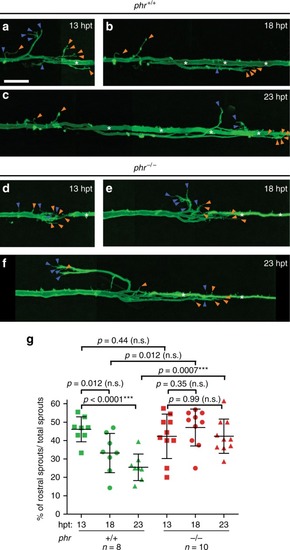
PHR is required to destabilize misdirected sprouts. Time-lapse imaging over 10 h of regrowing Mauthner axons in wild-type larvae and phr mutants, starting at 13 hpt. At 13, 18, and 23 hpt the regrown Mauthner axon of a wild-type larva (a–c) and a phr mutant (d–f) is depicted. At 13 hpt the regrowing Mauthner axons sprouted multidirectionally in both, wild type (a) and phr mutant (d). We quantified the number of all sprouts pointing either correctly caudally (more than 90° from the original proximal projection, a subset is labeled by orange arrowheads in a–f) or incorrectly rostrally (up to 90° from the original proximal projection, a subset is labeled by blue arrowheads in a–f). Quantification is shown in g. The data show that initially both phr mutant and wild-type axons displayed rostrally and caudally directed sprouts. While the percentage of rostrally directed sprouts remained high over time in phr mutants (f, g), the percentage decreased significantly in wild-type larvae at 23 hpt (c, g). Hence the percentage of rostrally directed sprouts was significantly higher in phr mutants at 23 hpt. This suggested that PHR directs regrowing axons, at least in part, by destabilizing misdirected sprouts. N = 10 phr mutants and n = 8 wild-type larvae were analyzed (one axon per fish). P-values were determined using two-tailed Student’s t-test, p-values ≤ 0.007 indicated significant differences after Bonferroni correction. Scale bar in (a) is 30 μm
|

